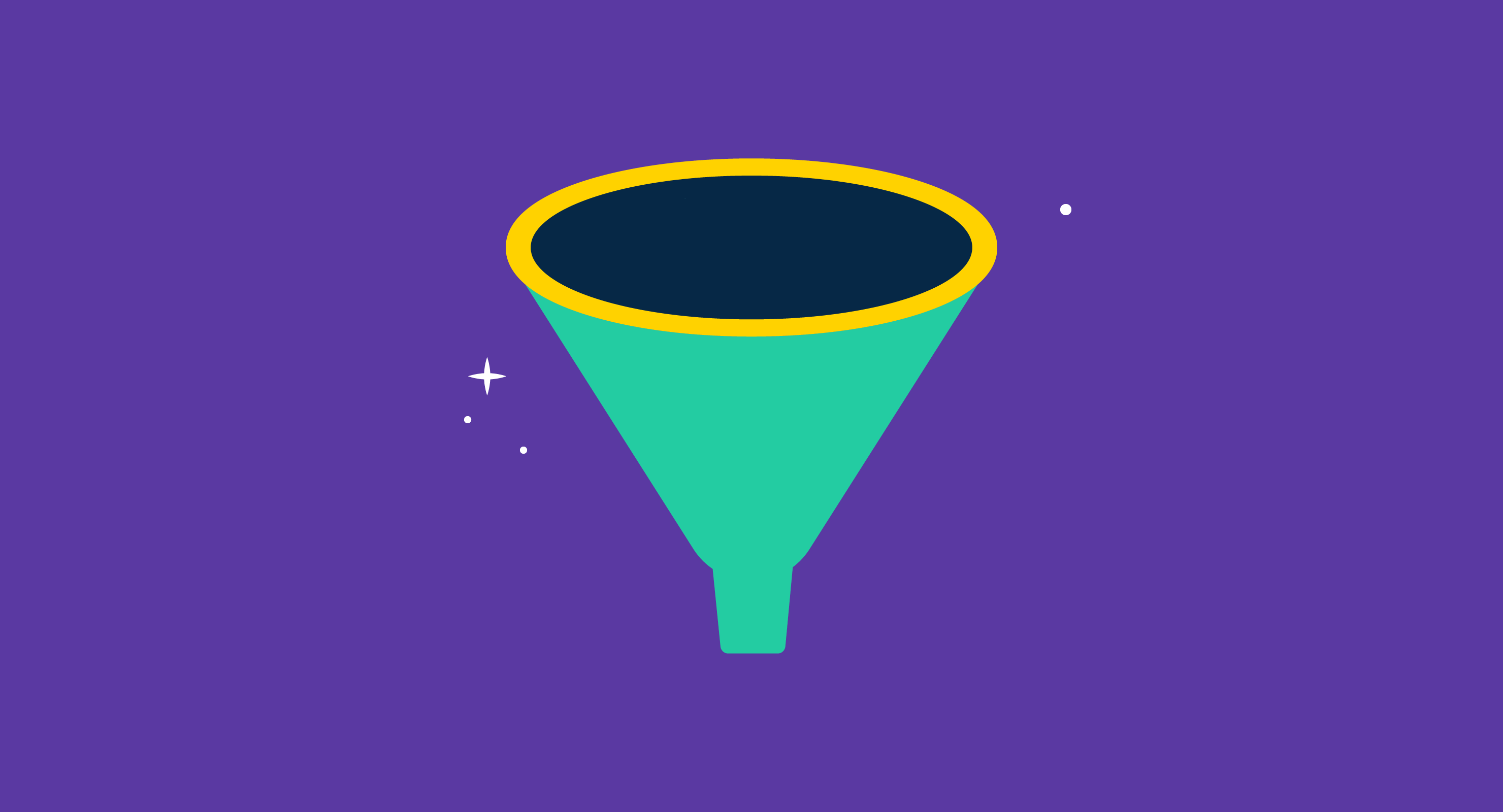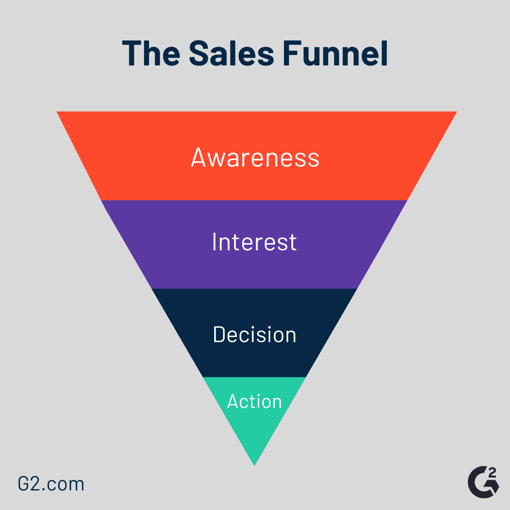December 2, 2020
 by Mary Clare Novak / December 2, 2020
by Mary Clare Novak / December 2, 2020

“Let me paint you a picture.”
For those visual learners out there, that’s a beautiful phrase to hear when dealing with complex information and data. Pairing an intricate process with a clearly laid out image of how to follow it can have a positive impact on the outcomes.
For sales reps dealing with potential customers, that representation comes in the form of the sales funnel. Often paired alongside the sales pipeline, sales funnels act as the end all, be all of your sales team’s progress.
A sales funnel, sometimes referred to as a marketing funnel, is a visual representation of the journey buyers go through as they convert from prospects into customers. Businesses typically separate sales funnels into top, middle, and bottom stages in reference to the potential customer’s current position.
Sales funnels are divided into the predetermined steps that a company’s buyers usually take on their journey to becoming a customer, offering the ability to visually see the progress that a rep is making in closing a deal. The further a customer moves down the funnel, the more likely they are to make a purchase.

The prospect’s current stage in the process will also determine the sales and marketing actions that a company will implement to convert them into a customer. The strategies of countless B2B and B2C companies have been crafted around a sales funnel informed by the buyer journey.
Business owners rely on the image of a funnel because a large number of potential customers will enter the top of the funnel, but after conversion rates are taken into account, only a percentage of that original number of prospects will result in a new customer.
After you’ve crafted your sales process and identified your typical buyer’s journey, the last thing you’ll want to do is add another iteration before you start selling. However, taking that extra step to illustrate a sales funnel can offer plenty of benefits for your sales reps and marketers, your company, and your customers.
First off, sales funnels can put you in your customers’ shoes. The stages laid out in your funnel will be accompanied with particular actions and thoughts that buyers commonly experience at that point in the process. With that insight, your sales and marketing teams can allocate the right follow up actions, create relevant messaging, and ultimately convert more prospects into customers.
Sales funnels also offer sales professionals with a method to be more organized. Depending on experience, it’s possible that your reps are handling more than one account. Seeing each prospect’s place in the sales funnel will help salespeople stay on top of their place in the buying process and designate actions accordingly.
Not every lead that enters the sales funnel is going to convert to a qualified prospect, opportunity, and then eventually a customer. Some will exit along the way before converting all the way. This fact of sales will not only inform your sales metrics and forecasts for an upcoming period, but it will also help you pick out weak points in your processes.
If a lot of prospects are exiting after receiving a value demonstration, maybe you need to revisit the benefits you list in that presentation. Or if you figure out your funnel is being filled with a bunch of unqualified leads, maybe your lead generation strategy needs to be reworked. This optimization is made possible by the different stages of the sales funnel.
Your leads and prospects technically enter the sales funnel the second they hear about and consider your business as a solution to a pain point they’re experiencing.
While the buyer's journey from that point forward might look a bit different for each person, as no customer is exactly the same, your sales funnel will most likely be composed of the following stages. The further down the funnel, the more promising the relationship.
The first stage of the sales funnel is referred to as the awareness stage. This sector refers to the point in time that a customer becomes aware that your business, product, or service exists. They might have heard about it through a Google search result , blog post, or maybe even a referral from a friend.
Gathering data regarding how your paying customers became aware of your business can be extremely valuable in optimizing your processes. It’s possible that a certain sales or marketing tactic that causes recognition sees more success, requiring more investment in that action.
While someone simply knowing your business exists might not immediately translate to the possibility of them becoming a customer, it actually does put them in the running. A customer can’t buy your solution if they don’t know you exist.
When a customer becomes aware of your company, it’s your job to move them further down the funnel. Your sales and marketing strategies, tactics, and materials will do the heavy lifting there and act as a lead magnet.
After the awareness stage comes the person’s interest in your brand, business, or product. A promising move and a step in the right direction.
A person’s greater interest in a business is often accompanied by a pain point they’re trying to resolve for their own company. Someone can become aware of your business and not think about it again until it’s relevant to a problem they’re experiencing.
The interest stage of the sales funnel involves actively looking for a solution. Potential customers will spend this time researching, comparing options, and interacting with vendors to see whether or not they’re a good fit.
It’s your job to provide them with the data, insight, and content they need to make that decision. Establish your expertise as a vendor, educate the prospect as much as possible, and make it known that you are a viable option.
Tip:Social proof can go a long way. Greater visibility in the form of customer reviews, case studies, and testimonials can boost your chances of making a sale. Make it happen by claiming your profile on G2 today.
At this point, the customer is ready to buy. They should have all of the information they need about your company and solution. However, during the decision phase, they’ll want even more detail about what it would look like if they chose to buy from you.
For the buyer, the decision phase will include sending a lot of requests for quotes to potential vendors, weighing the options, and asking themselves which offer would provide them with the most value. Customers will take the product into account as well as additional value propositions and their buying experience with each particular company.
For sellers, they’ll have to produce those price quotes and do everything they can to make sure they’re the primary option as a vendor. This is your chance to sway them in your direction.
The final stage at the bottom of the funnel is when the customer takes action and makes a purchase. Processes within the action stage including negotiating final prices, signing contracts, and getting a customer ready to be onboarded with the solution.
If a customer decides to buy your solution, your job is far from over. You need to make sure the customer is always heard and receiving benefit from your solution, team, and business. Nurturing your customer relationships is a full-time job, and neglecting that duty can cause churn and poor customer retention. You should always be offering support, asking for feedback, and exploring ways for the relationship to become even more valuable.
If the customer reaches the end of the funnel without making a purchase, try to schedule a follow up. Take a good look at their needs and ask yourself if your solution really was their best option. And never burn any bridges - you never know who might be reaching out to you again in the future.
As your customers move along in their buying journey, you have two options. You can either play it fast and loose and do your best to accommodate, anticipate, and meet their needs while also making a sale.
Or you can design a sales funnel unique to your business that will help streamline the entire process, lay out actions to take for particular buying signals, and optimize the value of the sale for both parties involved.
(Pick the second one.)
It sounds daunting, but don’t worry – here are some steps for creating a sales funnel that will help you construct the perfect design for your company.
A good sales funnel will reflect the journey of a business’ typical buyer. If it fails to do this, it’s a sentence for it to fail, misleading sales reps and ruining chances of a positive customer experience.
The first step of creating a successful sales funnel is to analyze and understand the behavior of your current buyers. The more you know about them, the better your funnel will reflect their patterns. Remember that you aren’t trying to sell to everybody. Your efforts should revolve solely around people who fit your buyer persona and are a likely candidate in becoming a customer.
Pay attention to things like buying signals, preferred communication channels, and content that converts the most prospects in the end. Take it even further back and figure back and find out why and how they found you in the first place. What’s their pain point? What is the most sought-after product feature?
Any data point or piece of information that can help instruct reps in moving prospects down the pipeline is relevant.
Now that you know who they are and what they’re looking for, it’s time to dedicate time, energy, and materials to grabbing their attention with relevant and helpful information. The most important note here is that you must have SEO optimized content for every stage of the sales funnel.
At the top of the funnel in the awareness phase, you’ll want to pump out some blog articles, social media posts, and webinars that offer useful information to your audience. There’s also the paid route of advertising.
As they move down and show interest in your business, your website should feature product information, comparisons with competitors, and customer reviews. From there, as they think about the decision of making a purchase, make it easy for them to connect with a sales rep through a landing page. And as they take action to buy, welcome them with open arms along with a thoughtful proposal and reasonable price quote.
When consuming some of your content, some prospects might be interested, but not sure of what to do next.
Your content is there to serve readers, but you also want them to convert into customers. Make sure that all top and middle of funnel content includes landing pages with clear calls to action (CTAs) and contact information forms. These pages can also include background information on your company and the unique benefits you offer to your customers.
When you get a prospect’s contact information, use it wisely. Start your sales cadence with some outreach and keep the information flowing. Ensure you’re communicating the value of your business and solution in a way that engages and intrigues customers enough to move forward.
Getting the customers contact information offers you the opportunity to start nurturing them through every title they will embody, from lead to prospect, prospect to opportunity, and hopefully, opportunity to customer.
This starts with keeping customers engaged and continuing to move them down the sales funnel, maybe with an email marketing campaign or a diversified sales cadence.
Honestly, it never really ends. Even after a customer has made a purchase, you can still nurture the relationship with additional customer support, upselling or cross-selling opportunities, or discounts for future purchases. Any tactic that can offer them more value counts as a nurturing technique.
Sales funnel management refers to the process of overseeing the customer journey and ensuring your pipeline reflects it as effectively as possible. Techniques for sales funnel management make efforts to keep everything streamlined, organized, and effective.
If customers exit the funnel without making a purchase, find out what went wrong. Is there a certain stage where some prospects tend to leave the funnel? Was there a signal that often led to customers exiting? What can be done differently to avoid this in the future?
The same goes for situations where communication with a customer falls flat before they get to the end of the funnel. Also known as a dead lead, these people might have expressed an interest in buying but have been unengaged for a while. In hopes of keeping your funnel as clean and manageable as possible, throw those leads away.
Obviously they aren’t too interested in your business, and it wouldn’t make sense for you to put any more effort into that unpromising relationship. If they make their way back to you, then great! If not, there is satisfaction in cleaning up your pipeline and knowing you can reallocate that time toward someone who will actually benefit from it.
Whatever the case may be, keep track of every customer interaction you have in your customer relationship management (CRM) solution. That way you can pick up right where you left off.
A cleaner and well-managed sales funnel can also result in faster sales cycles. Without worrying about unqualified leads, salespeople can focus their time on the customers who actually want to make a fast purchase, allowing them to move down the funnel quicker. The average sales cycle sits at 102 days, and anything that’s too long can result in an unengaged buyer.
Like any other business structure, you’ll need to measure its success to find the best way to optimize. For sales professionals, these sales funnel metrics shouldn’t come as too much of a shock, as they probably already exist somewhere else in your sales strategy.
Here are some common sales metrics you must measure to determine and optimize the success of your sales funnel:
Each of those metrics, along with their own moving pieces, can be used to your advantage. A bad month or quarter shouldn’t be thrown away and forgotten. It should be used as a learning experience.
Take all of this data and analyze what went wrong, what went well, and where things can be improved. Even if you perform well, there’s always room for optimization.
A person's journey to becoming a customer is not a one stop shop, and it's in your best interest as a seller to pay attention to those points along the way. A well-structured and informed sales funnel is the perfect answer, as it offers a recipe for a solid customer experience and closed won deals.
If you’re having a hard time keeping track of everything, learning more about how CRM software can help you bring order to your sales team.
Mary Clare Novak is a former Content Marketing Specialist at G2 based in Burlington, Vermont, where she is explored topics related to sales and customer relationship management. In her free time, you can find her doing a crossword puzzle, listening to cover bands, or eating fish tacos. (she/her/hers)
There's much debate in the sales industry over which sales key performance indicators (KPIs)...
 by Mary Clare Novak
by Mary Clare Novak
When presented with a task, our first thought is to explore options for the best approach.
 by Mary Clare Novak
by Mary Clare Novak
We’ve entered an era where customer expectations of how they want to interact with businesses...
 by Shane Murphy-Reuter
by Shane Murphy-Reuter
There's much debate in the sales industry over which sales key performance indicators (KPIs)...
 by Mary Clare Novak
by Mary Clare Novak
When presented with a task, our first thought is to explore options for the best approach.
 by Mary Clare Novak
by Mary Clare Novak


